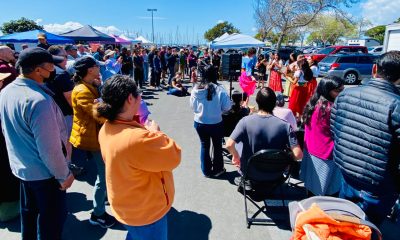Black History
Christmas During Slave Era: A Respite from Bondage or Continued Harsh Reality
In Wilmington, N.C., slaves celebrated ‘Jonkonnu’ a contraction of the name John Kunering. Dressed in costumes, the enslaved people went from house to house singing, dancing, and beating rhythms with rib bones, cow horns, and triangles. A gift was expected at every stop. Not all of Wilmington’s whites appreciated the festivities.

By Tamara Shiloh
Early accounts from white Southerners describe Christmas as a day of kindness and generosity. But the reality of what took place on December 25 during slavery was complex and, in many cases, dangerous.
In Wilmington, N.C., slaves celebrated ‘Jonkonnu’ a contraction of the name John Kunering. Dressed in costumes, the enslaved people went from house to house singing, dancing, and beating rhythms with rib bones, cow horns, and triangles. A gift was expected at every stop. Not all of Wilmington’s whites appreciated the festivities.
Some enslaved people could rest on the holiday; others were forced to work. Many owners hosted social events requiring the work of house slaves. In parts of the country, slaves were given a yule log to burn in the big house. They were granted rest for the same amount of time the log burned, often until New Year’s Day.
More trusted slaves were granted travel privileges to visit family. Gifts from owners were received including leftover food from plantation events. Slaves were given wine and alcoholic beverages for consumption, but according to a theory held by Frederick Douglass, it was not for holiday cheer.
The effects of alcohol were unknown to many slaves, leading most to overindulge. The drunken state would beckon sleep, halting runaways. Some masters traveled to nearby plantations to visit family; even slave catchers wanted time off. Thus, alcohol served as a method to keep the enslaved “in their places” as Christmas was known as the best time to escape to freedom.
A method used to gather slaves and convince them that bondage was their best option for living “peacefully and safely among the masters” was the showering of gifts. But not all slaves partook in the holiday’s so-called pleasures.
According to Robert E. May, a Purdue University professor of history, slaveowners’ fears of rebellion during the season sometimes led to “preemptive shows of harsh discipline. Their buying and selling of workers didn’t abate during the holidays. Nor did their annual hiring out of enslaved workers, some of whom would be shipped off, away from their families, on New Year’s Day.” This became known as heartbreak day.
In “A Slave’s Adventures Toward Freedom Not a Fiction, but the True Story of a Struggle” written by author Peter Bruner in 1918 recalled a personal Christmastime experience involving his owner: “… he was returning from town and so I thought I would catch his Christmas gift; it was always customary in those days to catch peoples Christmas gifts and they would give you something. Instead of giving me the kind of Christmas present I desired, he took me and threw me in the tan vat and nearly drowned me. Every time I made an attempt to get out, he would kick me back in again until I was almost dead. At last, I came up on the other side and jumped out before he was able to get around there.”
For some, traditions of Christmas were tools for celebration. For others, it was harsh treatment. Overall, most held long memories of the season and relished the moments of respite.
Activism
Oakland Post: Week of April 24 – 30, 2024
The printed Weekly Edition of the Oakland Post: Week of April 24 – 30, 2024

To enlarge your view of this issue, use the slider, magnifying glass icon or full page icon in the lower right corner of the browser window. ![]()
Activism
Oakland Post: Week of April 17 – 23, 2024
The printed Weekly Edition of the Oakland Post: Week of April 17 – 23, 2024

To enlarge your view of this issue, use the slider, magnifying glass icon or full page icon in the lower right corner of the browser window. ![]()
Black History
Matthew Henson: Explorer Extraordinaire
Matthew Henson, a trailblazing explorer who overcame countless obstacles to leave an incredible mark on history. Born on August 8, 1866, in Charles County, Maryland, his journey is a testament to the power of determination and the spirit of adventure.

By Tamara Shiloh
Matthew Henson, a trailblazing explorer who overcame countless obstacles to leave an incredible mark on history. Born on August 8, 1866, in Charles County, Maryland, his journey is a testament to the power of determination and the spirit of adventure.
Henson’s life began amidst the backdrop of post-Civil War America, where opportunities for African Americans were scarce. From a young age, he possessed an insatiable curiosity about the world beyond his small town. At the age of 12, he embarked on a journey that would change the course of his life forever when he joined a merchant ship as a cabin boy.
His most famous expedition was his journey to the Arctic with renowned explorer Robert E. Peary. In 1887, Henson joined Peary’s crew as a seaman and quickly proved himself to be invaluable with his skills as a navigator and craftsman. Over the course of several expeditions, Matthew endured extreme cold, treacherous terrain, and grueling conditions as he and Peary sought to reach the elusive North Pole.
In 1908–09, Peary set out on his eighth attempt to reach the North Pole. It was a big expedition, with Peary planning to leave supplies along the way. When he and Henson boarded their ship, the Roosevelt, leaving Greenland on August 18, 1909, they were joined by a large group. This included 22 Inuit men, 17 Inuit women, 10 children, 246 dogs, 70 tons of whale meat, blubber from 50 walruses, hunting gear, and tons of coal.
In February, Henson and Peary left their anchored ship at Ellesmere Island’s Cape Sheridan, along with the Inuit men and 130 dogs. They worked together to set up a trail and supplies along the way to the Pole.
Peary picked Henson and four Inuit people to join him in the final push to the Pole. However, before they reached their destination, Peary couldn’t walk anymore and had to ride in a dog sled. He sent Henson ahead to scout the way. In a later interview with a newspaper, Henson recalled being in the lead and realizing they had gone too far. The group turned back, and Henson noticed his footprints helped guide them to their destination. At that location, Henson planted the American flag.
Henson’s legacy extends far beyond his expeditions to the Arctic. He shattered racial barriers in the world of exploration and inspired countless individuals, regardless of race, to dream big and pursue their passions. In 1937, he was finally recognized for his achievements when he was inducted into The Explorers Club, an organization dedicated to promoting scientific exploration and field research.
Matthew Henson died in the Bronx, New York, on March 9, 1955, at the age of 88.
-

 Community2 weeks ago
Community2 weeks agoFinancial Assistance Bill for Descendants of Enslaved Persons to Help Them Purchase, Own, or Maintain a Home
-

 Activism4 weeks ago
Activism4 weeks agoOakland Post: Week of April 3 – 6, 2024
-

 Business2 weeks ago
Business2 weeks agoV.P. Kamala Harris: Americans With Criminal Records Will Soon Be Eligible for SBA Loans
-

 Community2 weeks ago
Community2 weeks agoAG Bonta Says Oakland School Leaders Should Comply with State Laws to Avoid ‘Disparate Harm’ When Closing or Merging Schools
-

 Activism3 weeks ago
Activism3 weeks agoOakland Post: Week of April 10 – 16, 2024
-

 Community2 weeks ago
Community2 weeks agoOakland WNBA Player to be Inducted Into Hall of Fame
-

 Community2 weeks ago
Community2 weeks agoRichmond Nonprofit Helps Ex-Felons Get Back on Their Feet
-

 Community2 weeks ago
Community2 weeks agoRPAL to Rename Technology Center for Retired Police Captain Arthur Lee Johnson

















































